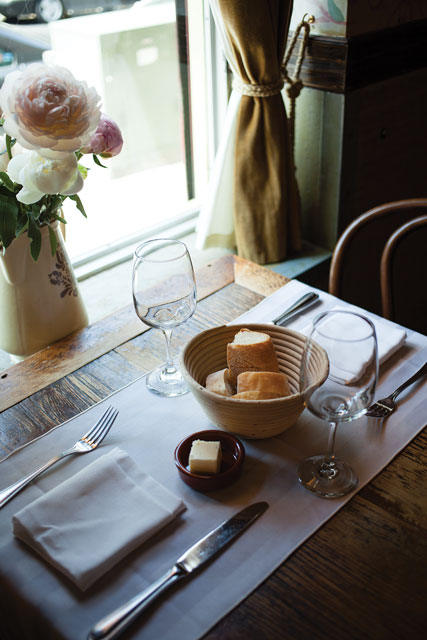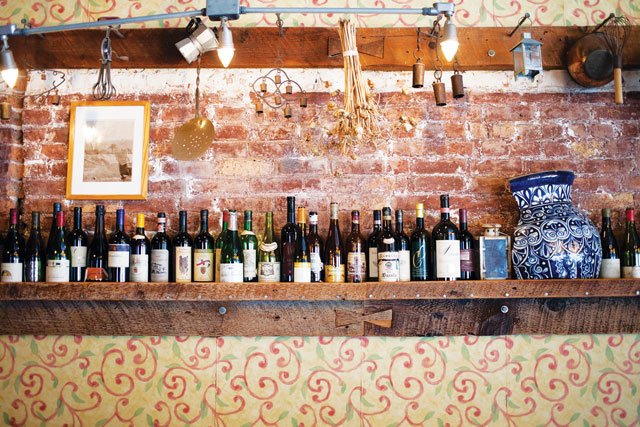15 Years of Al Di La: A Retrospective

Chef Anna Klinger, of the reputable and always-packed Al Di La, attributes her love of cooking to her mother. Having grown up in Westchester County, food played a large and important part in Klinger’s family and early life. Like many women of her generation, Klinger’s mother taught herself to cook by reading Julia Child classics and watching the six-foot-two Californian whip up omelettes and beef bourguignon on television.
During high school Anna Klinger began cooking rather seriously, making meals for her friends after school. Upon graduating, Klinger moved to the big city to attend NYU where she studied art history and anthropology, disciplines that Klinger observed, “seem to often overlap with careers in food and cooking.” Anna Klinger’s post-college years led her to San Francisco, where she started working in the kitchen of the renowned French restaurant, La Folie.
Not everyone in Klinger’s life understood her choice to pursue a career as a chef. The crazy hours, the financial riskiness, and the challenge of having a family were all potential issues that concerned the people who cared about her. Ultimately, however, they came around and were happy that she had discovered a passion and were supportive of her pursuit.
Klinger loved food right away. Looking back on the emergence of her culinary career, Klinger reminisced: “[Cooking] clicked and felt right immediately. I loved everything about it. I sort of dropped everything else in my life and dove in.” She loves the generous act of making a meal for someone else, the speed with which everything happens (ingredients chopped, heat applied, and diners served), and the creativity involved. Klinger also finds the camaraderie and adrenaline rush of working in a kitchen to be unparalleled.
 San Francisco was Klinger’s home for several years before she transplanted to Italy. A friend was moving to the beautiful Northern Italian heartland to teach at a cooking school in Verona, and Klinger traveled with her planning merely to visit. As it turned out, the school was understaffed so Klinger decided to defer her return home and lend a hand in the kitchen. It was here where she met Emiliano Coppa, the manager of the cooking school, who would eventually become her husband and business partner.
San Francisco was Klinger’s home for several years before she transplanted to Italy. A friend was moving to the beautiful Northern Italian heartland to teach at a cooking school in Verona, and Klinger traveled with her planning merely to visit. As it turned out, the school was understaffed so Klinger decided to defer her return home and lend a hand in the kitchen. It was here where she met Emiliano Coppa, the manager of the cooking school, who would eventually become her husband and business partner.
Klinger moved back to New York in the early nineties, and during this period she and Coppa maintained a long-distance relationship. Emiliano would come to NYC for a few months, return to Italy, and then travel back to the states again. The bouncing back and forth worked for awhile, but once Klinger stumbled upon a great apartment on Sterling Place in Park Slope, it finally made sense for Coppa to move to New York permanently.
The apartment was lovely, and, as was typical of Brooklyn apartments in the mid-nineties, actually affordable. Once they settled in Park Slope, Klinger and Coppa took a closer look around; despite the high demand one might expect from the influx of young people moving into the neighborhood, there wasn’t all that much available in the restaurant department. Aunt Suzie’s, Cucina, and Lemongrass Grill were considered Park Slope’s gastronomic highlights at that time. It would be entirely accurate to say that there was a niche to be filled, and Klinger and Coppa happened to be the ones to fill it.
To this day, fifteen years after opening, Al Di La is considered one of Brooklyn’s original pioneering restaurants. Klinger explains that “[Al Di La] was not the first…but we were the beginning.” When the duo first told people about their plans to open up a restaurant on Fifth Avenue in Brooklyn, they were met with many raised eyebrows. People responded as though it would be “crazy” or “dangerous” to open a restaurant in “that part of Brooklyn.”
Yet Klinger and Coppa weren’t deterred by the skeptics and purchased the former Tofu Garden space, a Chinese, Thai, and Spanish restaurant on the corner of Fifth Avenue and Carroll Street. They were at once tasked with the daunting, yet exciting work of a major rehab. Coppa, who had a background in woodworking and food styling, went to work on the space with a friend. They peeled off pictures of crabs from the awning outside, built long wooden tables, and removed dropped ceilings to expose a beautiful tin ceiling from which they hung an elaborately-decorated chandelier that belonged to Emiliano’s grandmother in Venice. The former Chinese-Thai-Spanish formica palace was transformed into the rustically-styled Al Di La trattoria.
 Al Di La’s menu is comfortably Northern Italian, with strong odes to the region of Veneto. Many of the restaurant’s staples have received a fair amount of media attention in the past. Braised rabbit with black olives and creamy polenta; stewed cuttlefish and oxtail with garlic and chili; and the swiss chard-ricotta malfatti in sage-infused brown butter could even be called classics. Klinger has received occasional criticism for not modifying the menu more, but she is quick to point out that Al Di La’s offerings actually do change as certain dishes (or componenets of dishes) vary according to what is seasonally available.
Al Di La’s menu is comfortably Northern Italian, with strong odes to the region of Veneto. Many of the restaurant’s staples have received a fair amount of media attention in the past. Braised rabbit with black olives and creamy polenta; stewed cuttlefish and oxtail with garlic and chili; and the swiss chard-ricotta malfatti in sage-infused brown butter could even be called classics. Klinger has received occasional criticism for not modifying the menu more, but she is quick to point out that Al Di La’s offerings actually do change as certain dishes (or componenets of dishes) vary according to what is seasonally available.
From 1998 to 2006, Anna and Emiliano were content and busy with their one small Venetian restaurant; Coppa managed the front of house, while Klinger oversaw the kitchen. Eventually though, they grew increasingly aware of just how popular their restaurant had become. They wanted to make sure more people had the opprotunity to experience their cuisine, so in 2006, they opened Al Di La Vino, a wine bar next door on Carroll Street. Then in 2012 and again in 2013, Anna and Emiliano partnered with the long-time manager of Al Di La to open Bar Corvo and Lincoln Station in Prospect Heights.
According to Klinger there aren’t any new plans for opening additional restaurants in the near future, but she alluded to another upcoming project: a cookbook. Having attempted the project two times previously, Klinger hasn’t yet been able to write the type of “crafted and personal” cookbook she wants to publish. But the idea is quite presently on the table.
When asked whether she feels she made the right decision to purchase the dumpy Hispano-Asian fusion restaurant and transform it into Al Di La, all Klinger can say is, “Yeah. I feel really lucky. Things fell into place in a great way. We were just so fortunate.” And so are we.

Leave a Reply